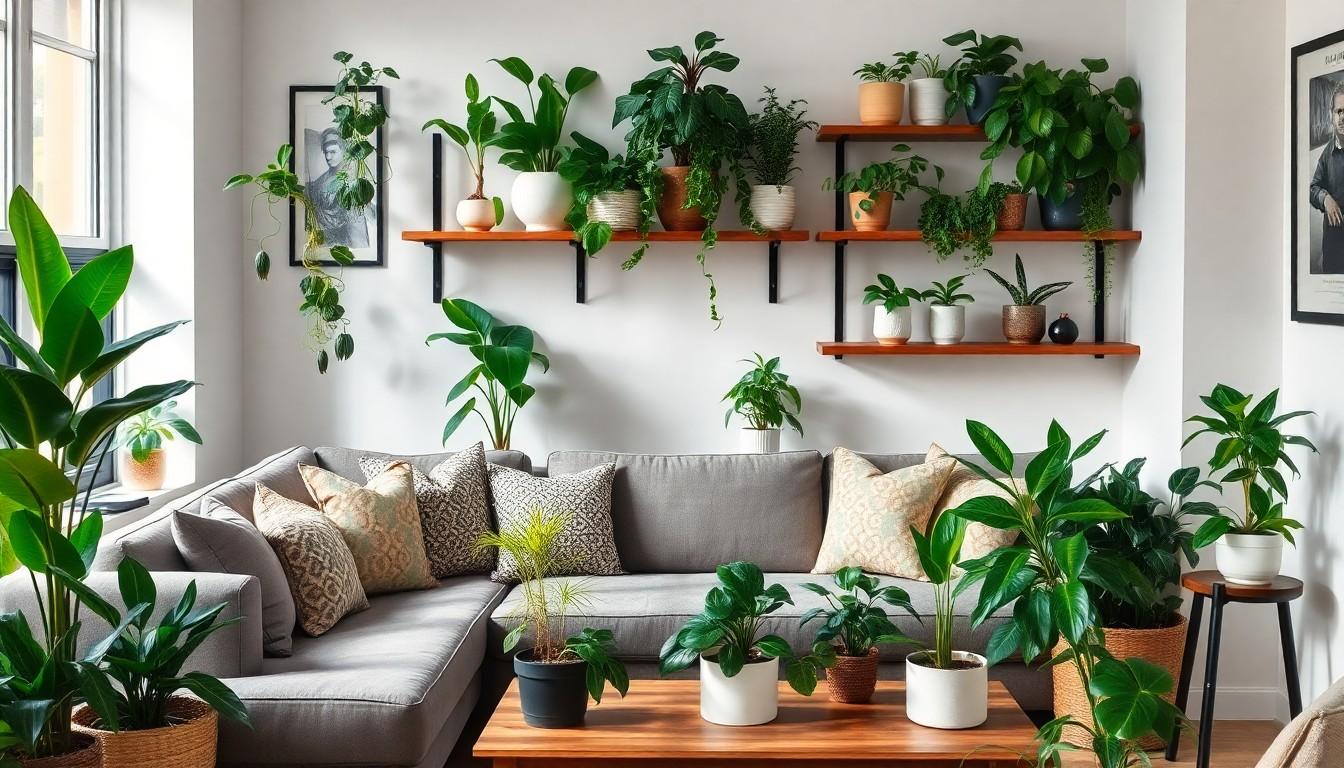Starting a plant collection can feel like diving into a jungle of confusion, especially for beginners. With so many options, it’s easy to get overwhelmed. But fear not! The right house plants can transform any space from drab to fab without requiring a degree in botany.
Overview Of Good House Plants For Beginners
Choosing appropriate house plants can boost indoor aesthetics and improve air quality. Some excellent options for beginners include snake plants, pothos, and ZZ plants. Snake plants tolerate low light and irregular watering, making them resilient choices. Pothos thrive in various environments and grow quickly, requiring minimal maintenance.
ZZ plants adapt well to neglect, surviving in low light and with infrequent watering. Spider plants also rank high for beginners due to their ability to purify air and propagate easily.
Peace lilies offer beautiful white blooms, along with air-purifying qualities. These plants thrive in indirect sunlight and flourish with consistent moisture.
Rubber plants stand out for their glossy leaves that add elegance to any room. They handle moderate light and only need watering when the topsoil dries. Cast iron plants, aptly named for their toughness, excel in challenging environments, whether low light or neglect.
Beginner-friendly plants often require limited expertise or special care. The right choice can create an inviting atmosphere while simplifying the care process. Setting up a watering schedule helps maintain healthy plants without overwhelming beginners.
Researching care requirements ensures that plant selections contribute positively to the home environment. Emphasizing resilience and beauty in these options makes houseplant ownership enjoyable and rewarding.
Benefits Of Having House Plants

House plants offer various advantages that enhance home living. These benefits include improved air quality and aesthetic appeal.
Improved Air Quality
Plants naturally filter the air, removing pollutants and increasing oxygen levels. Studies show that plants like peace lilies and snake plants significantly reduce toxins such as formaldehyde and benzene. Increased humidity levels also result from house plants, providing a more comfortable environment. Moreover, cleaner air contributes to better health outcomes, reducing headaches and respiratory issues. Novice plant owners can enjoy these air-purifying benefits with minimal effort.
Aesthetic Appeal
House plants add beauty and style to any space, transforming dull areas into inviting environments. Greenery creates a calming atmosphere, enhancing mood and comfort. Varieties like pothos and rubber plants offer diverse leaf shapes and colors, catering to different tastes. Arranging plants in creative ways, such as on shelves or in groups, can further elevate a room’s appearance. Incorporating house plants not only decorates but also personalizes living areas, making them feel more like home.
Top House Plants For Beginners
Selecting house plants that thrive with minimal effort can make plant ownership enjoyable. Here’s a closer look at some ideal choices for beginners.
Snake Plant
Snake plants, known for their striking upright leaves, tolerate low light and irregular watering. These hardy plants thrive in various conditions, making them perfect for novice gardeners. Consequently, neglect isn’t a concern, as they can survive droughts without wilting. In addition to their low maintenance, snake plants improve indoor air quality by filtering toxins, creating a healthier living space.
Pothos
Pothos, with its vibrant trailing vines, adapts well to different lighting conditions, from bright spaces to dim areas. Its fast growth makes it a rewarding choice for beginners eager to see results. Additionally, this plant requires infrequent watering, reducing the likelihood of overwatering issues. The heart-shaped leaves not only add aesthetic appeal but also work effectively to purify the air, promoting a more refreshing environment.
Spider Plant
Spider plants feature arching green and white striped leaves and produce small “pups” that can be easily propagated. They flourish in bright, indirect light but also tolerate lower light levels, accommodating various home environments. Regular watering is essential, though these plants are forgiving if neglected occasionally. Their ability to remove indoor pollutants makes them an excellent choice for health-conscious individuals.
ZZ Plant
ZZ plants showcase glossy leaves that reflect light beautifully, enhancing any indoor space. They thrive in low light and require minimal watering, often only needing attention every few weeks. This makes them an excellent option for busy individuals or those new to plant care. Beyond their aesthetic value, ZZ plants also filter indoor air, contributing to a cleaner atmosphere in homes.
Care Tips For Beginner House Plant Owners
Caring for house plants can be simple and rewarding. Following a few essential tips can enhance the plant’s health and beauty.
Watering Practices
Watering requires attention. Most beginner plants prefer the soil to dry out between waterings. Snake plants and ZZ plants thrive on neglect, needing thorough watering only when the soil is completely dry. Overwatering can cause root rot, a common issue for new owners. A good practice is to check the moisture level by sticking a finger into the soil. If it feels dry, it’s time to water, ensuring to give enough water until it drains from the bottom.
Light Requirements
Light conditions vary significantly. Snake plants tolerate low light but thrive in indirect sunlight. Pothos flourish in various light settings, adapting easily to dim corners. Conversely, spider plants appreciate bright, indirect light for optimal growth. Placing plants in the right light creates healthier growth and vibrant foliage. Regular adjustments may be necessary depending on the season’s sunlight intensity.
Fertilization Guidelines
Fertilizing promotes healthy growth. During the growing season, from spring to summer, using a balanced fertilizer every 4-6 weeks supports plants like rubber and peace lilies. A light application ensures the nutrients are absorbed without overwhelming the plant. During the dormant season in fall and winter, reducing or stopping fertilization is beneficial. However, occasional feeding with a diluted fertilizer can keep plants well-nourished.
Conclusion
Starting a house plant collection can be a fulfilling journey for beginners. With the right choices like snake plants and pothos, anyone can enjoy the beauty and benefits of indoor greenery. These resilient plants not only enhance living spaces but also contribute to better air quality.
By following simple care tips and understanding each plant’s needs, new plant owners can create a thriving environment. Embracing house plants brings joy and a sense of accomplishment, making it an enriching hobby that brightens any home.

